
So named for the line of iron based exhibits that front the west side of the pathway…
MO#8A
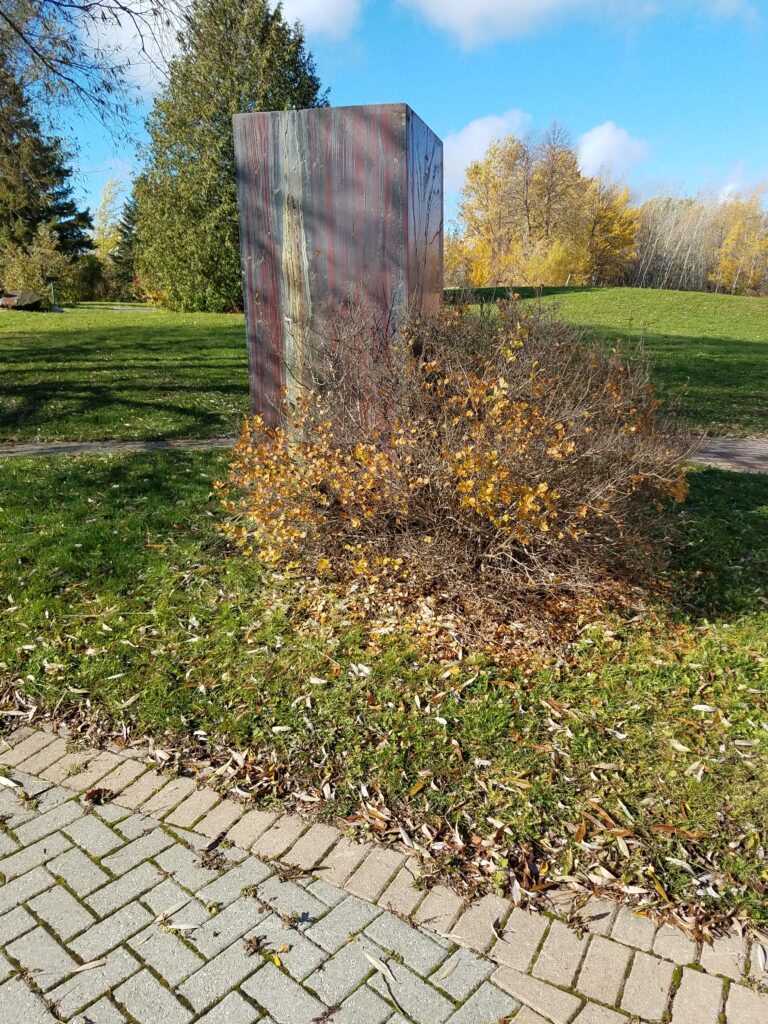
The Sherman Block: This large rectangular block is the original sample that eventually led to the founding of this park. This sample was cut and polished to form part of the entranceway to the Sherman Mine offices located north and west of Temagami. When the mine closed in the 1980’s, Cleveland Cliffs donated the sample to the Haileybury School of Mines, but unfortunately it was unloaded too near a geophysical base station, and the strong magnetism played havoc with readings for certain geophysical instruments. It was at this point that the idea of RockWalk Park was born, since the block had to be moved anyway.
The sample is comprised of ‘Banded Iron Formation’ (aka BIF) that are the main source of the world’s iron. BIF accounted for about 15% of the world’s sedimentary rocks that were deposited before 1.7 billion years ago. According to Dr. Nick Eyles in “Ontario Rocks”, oxygen first began to be produced on a large scale by cyanobacteria that were capable of photosynthesis. Before this time, the oceans carried huge volumes of dissolved iron that cyanobacteria consumed and deposited as layers on the seabed. In the process, Eyles proposes that the organisms generated oxygen by photosynthesis which in turn caused the initial rusting of iron. Today, these bacteria still exist as plankton in the cool oceans and even hot springs on both land and under water globally, producing oxygen.
See Internet dedication: Sherman Mine – Mininglifeonline.net
Internet explanations…seek: Canada (Ontario) Beneath Our Feet: Oxygen in Earth’s Atmosphere
See Amazon books: Nick Eyles: Ontario Rocks: Three Billion Years…
Exhibit in memory of Geologist Paul Bateman, the visionary leader of RockWalk Park. Teacher, Haileybury School of Mines, Northern College.
MO#8A1
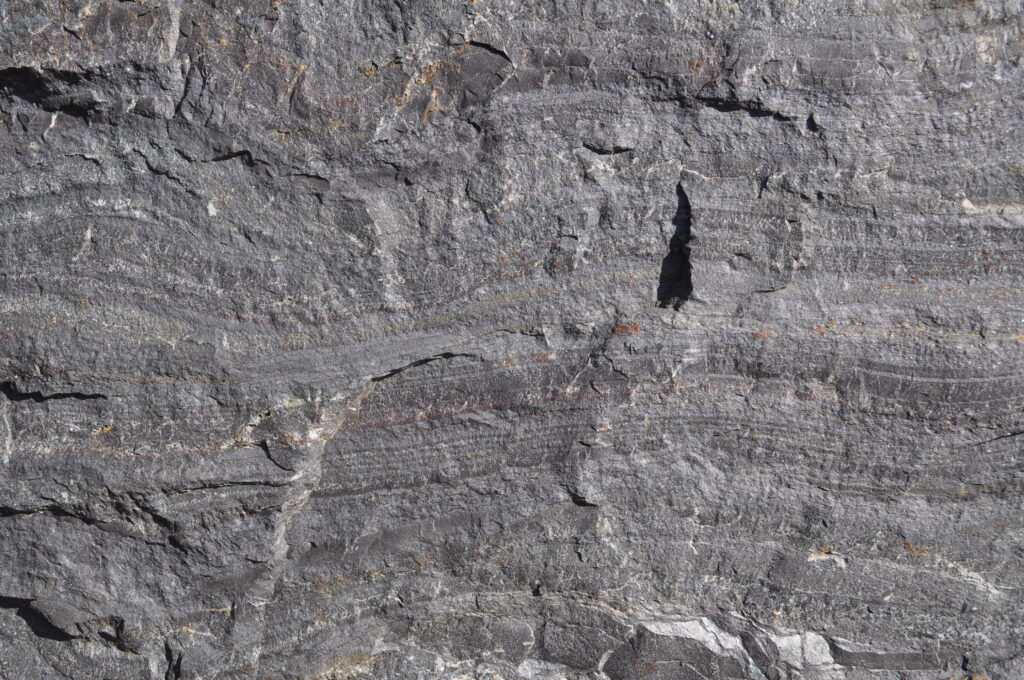
The next two samples come from the Sherman mine at Temagami, just like the large rectangular block (MO#8A) mentioned above. All of these iron ore samples display ‘iron formation’ insofar as bands of dark grey iron mineralisation (magnetite – the actual ore, composed of iron oxide, which is strongly magnetic, with a black streak) alternate with bands of silica. In this case, the silica is a more ‘normal’ colour, that is, grey, and the silica in this case is usually called chert.
Signage sponsored by Nor-Arc Steel Fabricators (Earlton, Ontario)
Internet geology report…seek: geoscan.nrcan.gc.ca + Sherman Mine
MO#8A2
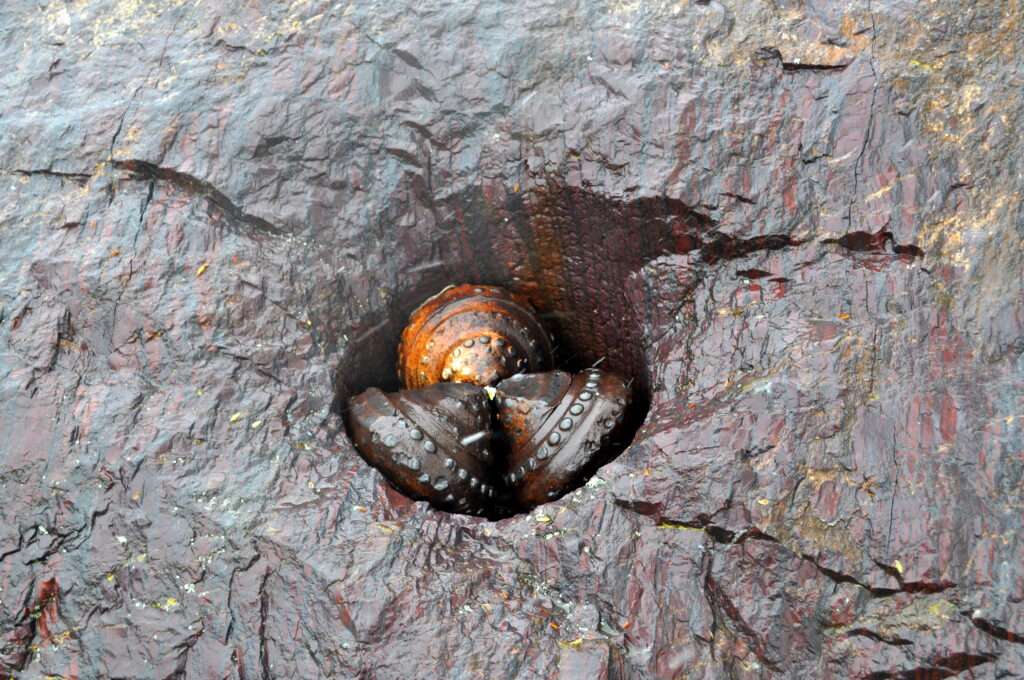
In this second iron ore sample from the Sherman Mine, the silica has been coloured by small amounts of iron to ‘stain’ the material bright red. This is the red mineral called jasper. In this specimen, we can see an example of a 9⅞” tri-cone rotary drill bit. It was used to drill 50 foot vertical blast holes in the pit prior to filling the rock with explosive charges.
Signage Sponsor: Alvin Caldwell Sand & Gravel (New Liskeard, Ontario)
Internet video – open pit mine drills see: Bucyrus-Erie 40-R documentary
MO#8B
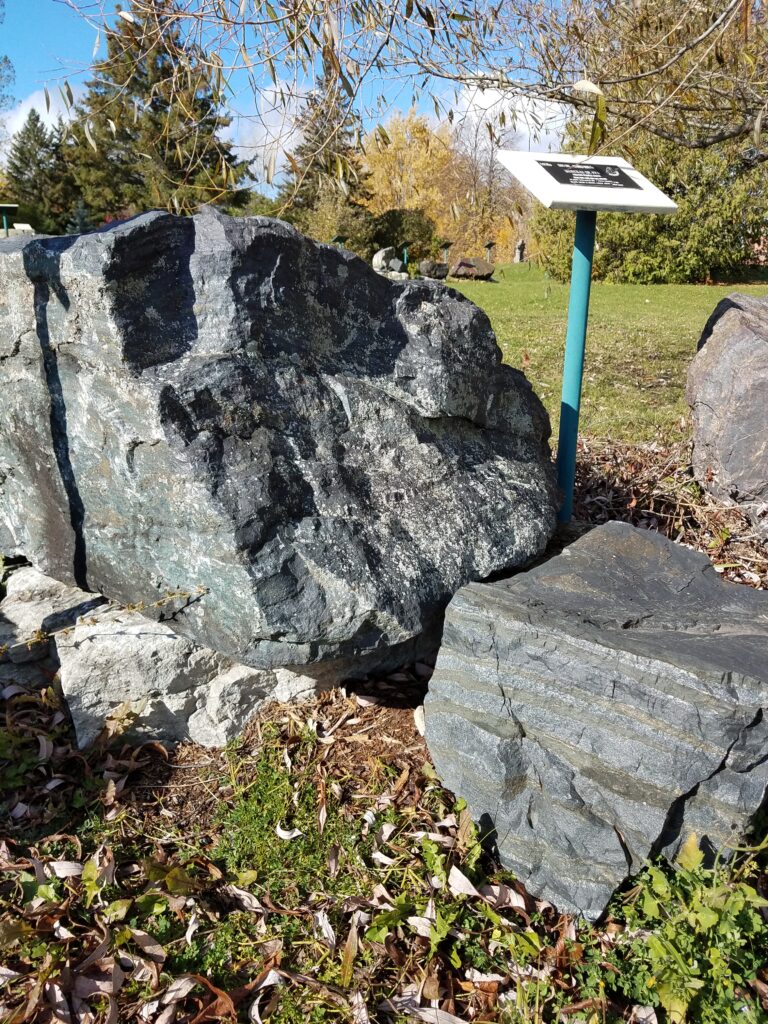
The second group of samples is from a 100 Metric ton deposit of Banded Iron Formation grading an average 22% magnetic iron. The Magnetite layers, alternating with grey chert, were mined in the six pits of the Adams Mine, just south of Kirkland Lake. The final product was 1.2 metric tons of iron pellets, grading 67% iron, per year. Discovered in 1906, the mine operated from 1963 to1990.
Of the three samples exhibited here, the large one is of similar banded minerals to that seen at the Sherman mine. The two smaller ones contain considerable amounts of another iron mineral, pyrite (iron sulphide – brass yellow in colour, and commonly in cubic form) was considered to be waste. Note that sample UNGS#11 (in the unusual geological structures section of this park) also comes from the Adams Mine.
Signage in memory of John D. Gambles, Electrician, The Adams Mine
Internet mine history seek: Adam’s Mine – Ontario Abandoned Places
MO#8C1
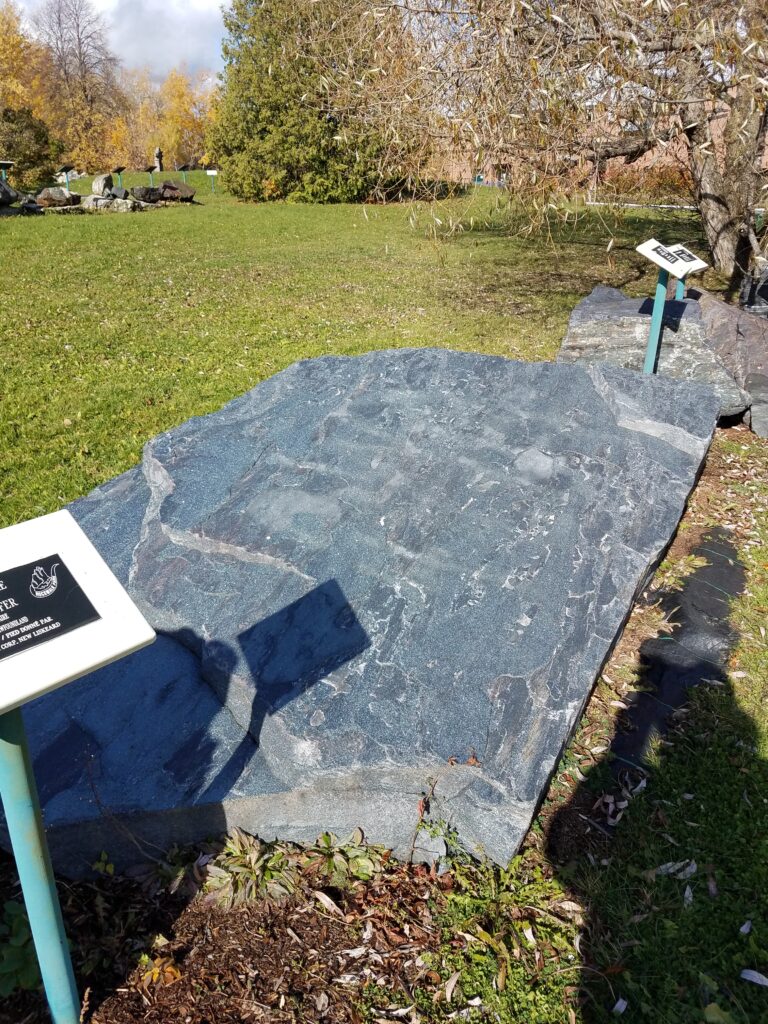
This large sample comes from the Mount Wright deposit of QCM (Quebec Cartier Mining Co) at Fermont, Quebec (near the Labrador border). The ‘ore’ mineral in this case is the bright silver-coloured mineral, which is specular hematite (another form of iron oxide from the magnetite seen in MO8A – here, streak is brick red).
French video : Institut national des mines du Quebec – Mont-Wright 1
MO#8C2
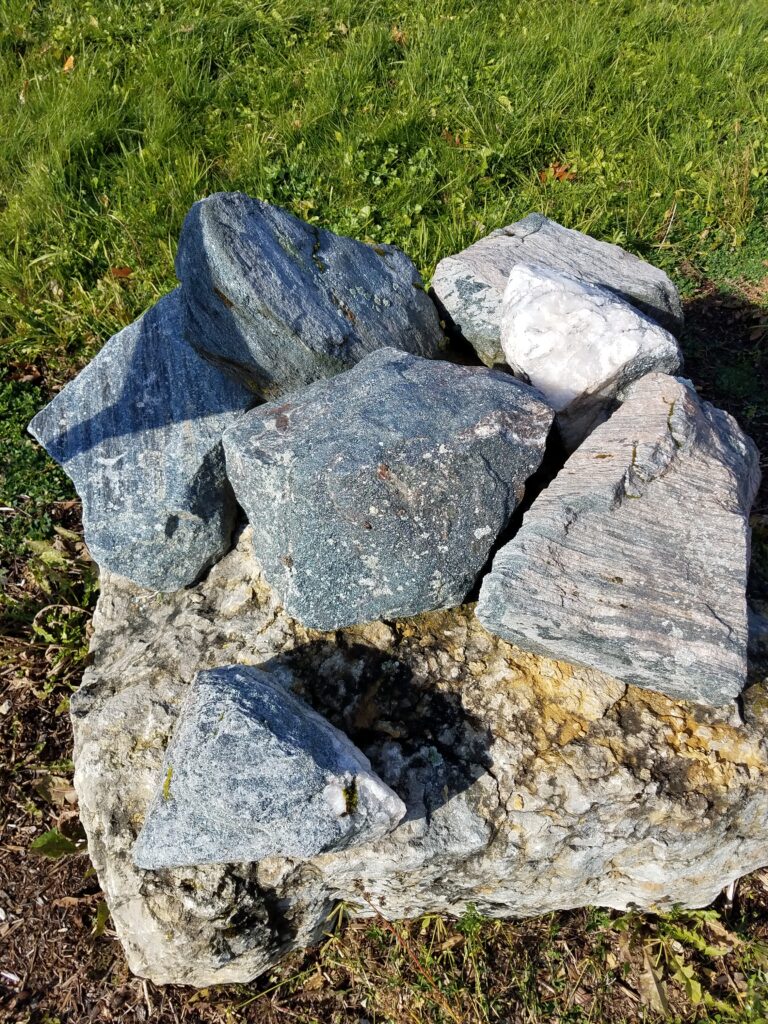
NOTE: This exhibit is out of position as it was collected more recently. (Find it 3 locations further south,)
This exhibit of IRON (Hematite) comes from the Fire Lake deposit within the Quebec section of the “Labrador Trough”. It is an hour north of the abandoned mining town of Gagnon. The zone is highly folded and metamorphosed. Specular hematite iron formations are the most important rock type in the area. Originally, the Fire Lake hematite went to the Lac Jeannine concentrator at Gagnon, but it was also sent by rail to the mount wright milling complex at Fermont, Quebec.
Signage dedicated to exhibit collector Nathan Mountain.
Internet history…seek: Fire Lake Mine (ArcelorMittal) – MinesQC
MO#8C3
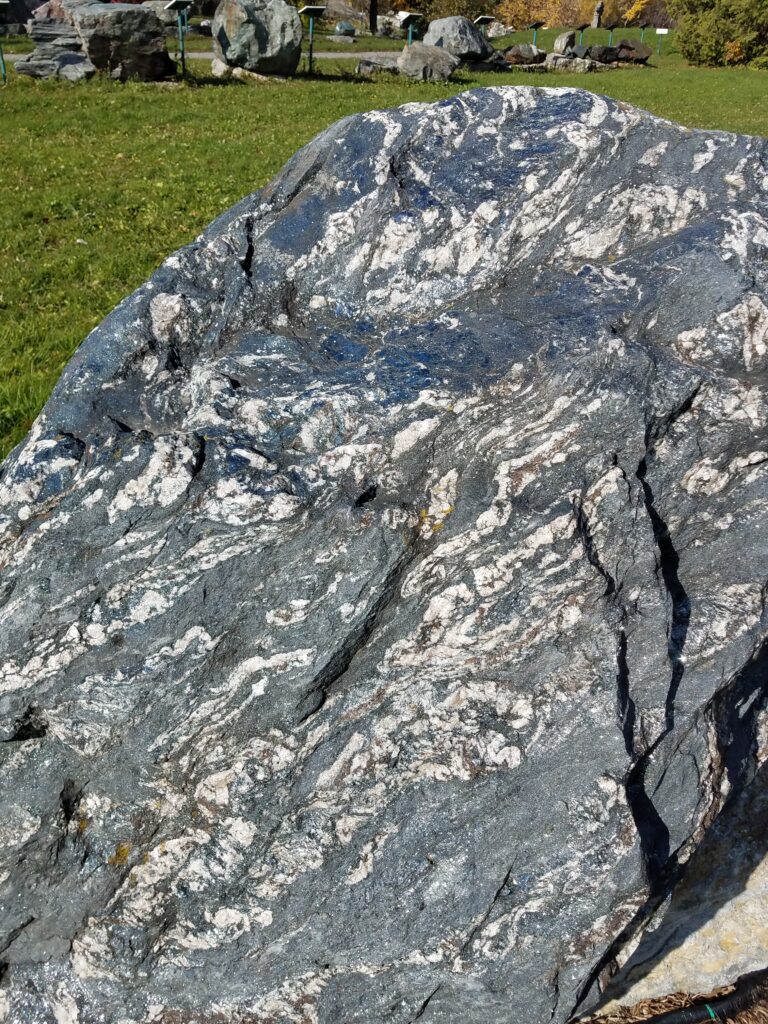
This sample shows specular hematite again; only this time the mineral has a larger grain size, yielding a brighter surface in certain spots. The large specular hematite grains have to be separated from the rest of the rock (the ‘waste’) to obtain concentrated iron ore. The iron ore represented here is from the Iron Ore Company of Canada pits at Labrador City, Newfoundland & Labrador.
Internet – CBC link: New mining pit in Labrador West extends IOC mine
MO#8D
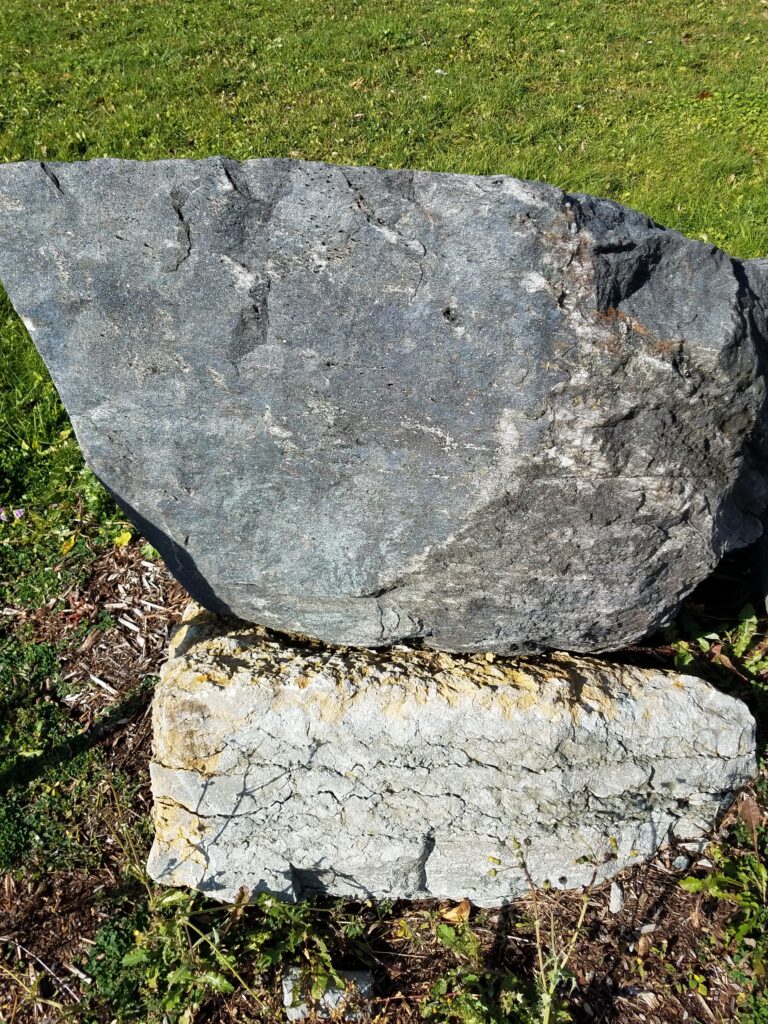
Yet another example of the specular hematite iron ores of the Labrador Trough, this piece comes from Wabush Mines (Scully Mine) in the town of Wabush, Newfoundland & Labrador. The banding in this sample is less obvious, although there is a faint foliation to the overall mass. Since a large portion of this sample is too hard for efficient milling, it is actually separated as waste. In contrast, the actual ore is so friable that it can be loaded directly from the pit without blasting, using a front-end loader.
This signage is a Memorial to Timothy R. Eby, 1965 Mining Technology Alumus. Mgr. of Scully Mine, Co-owner/Mgr. of Norcast Inc, Owner/President of Wabi Iron & Steel Corp, (New Liskeard); advocate for Haileybury School of Mines and RockWalk Park, Haileybury School of Mines Advisory Committee.Internet update…seek: www.tacoraresources.com
MO8#E
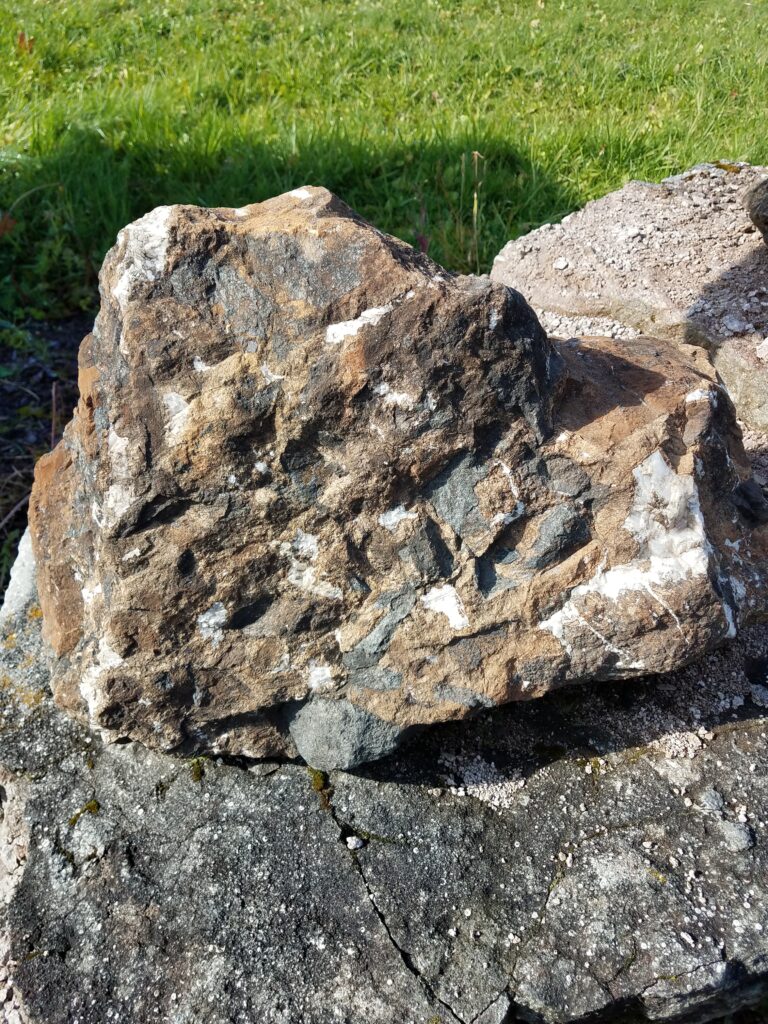
These smaller exhibits are the remains of the iron ore deposit that was found under Steep Rock Lake (Atikokan) in N.W. Ontario. They represent the “red” ore and the “black” ore. The mine is famous for the way that it was found, having no determining surface exposure. However, in 1891, boulders containing iron were found on the south shore. Sampling of regional glacial drift for iron particles pointed out that the source of the iron could only be from under the lake. Winter diamond drilling from the surface of the ice confirmed this in 1938. With the start of WWII, a high demand for iron encouraged the development of the prospect. By 1943, dams had been installed to divert the Seine River and pumps drained the central part of the lake. The summer of 1944 saw the dredging of sludge from the lake bottom and iron was being mined by October 3/44. That shipment went to Duluth, Minnesota to be turned into war goods. Over time, 4 open pits and one underground mine were created in this orebody. Even a nearby glacial deposit that was high in iron was considered to be an orebody and mined. By 1980, the entire operation was closed.
Internet video…seek:
1. Canada Busts Ore Output (1948) + British Path
2. Ed Monton film: Atikokan Ontario Steep Rock Iron Mine 1950